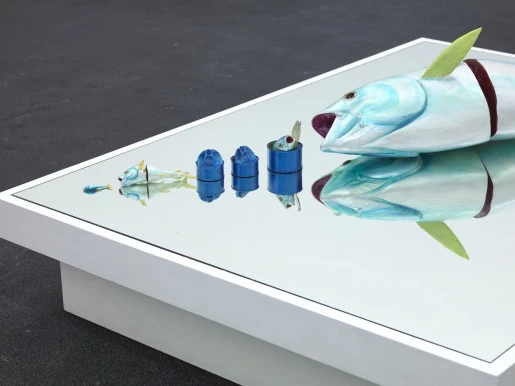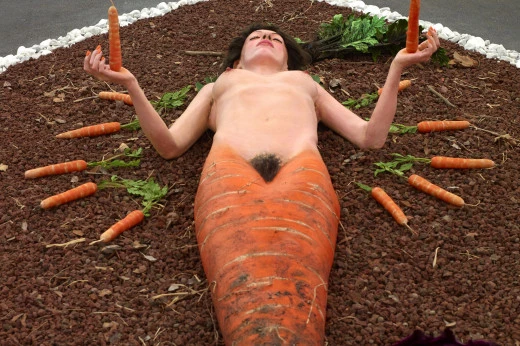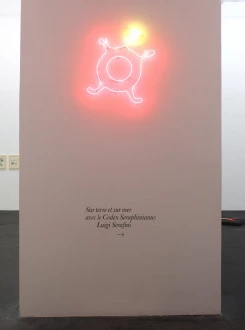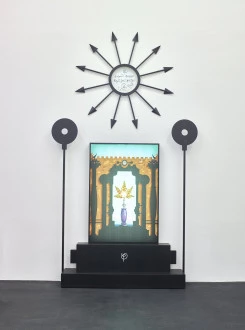Reverse Universe : "Sur terre et sur mer avec le Codex Seraphinianus"
Exhibition
From 10 October 2020 to 5 September 2021
Curator: Marie de Brugerolle
Reverse Universe offers the chance to cross two singular worlds of imagination, those of Luigi Serafini (born in Rome in 1949, lives and works in Rome and Milan) and Than Hussein Clark (born in 1981 in Exeter, New Hampshire, lives and works in London). Curated by Marie de Brugerolle, the exhibition Reverse Universe consists of two distinct journeys mixing sculptures, paintings, videos, photography, poetry and sound works, produced for the occasion or shown for the first time in an exhibition.
For Marie de Brugerolle, what is at play is the question of the hybridisation of bodies and forms, as well as the crossing of boundaries, their transgression, whether they be physical, geographical, linguistic or cultural. Although state boundaries are being reinforced under the pressure of an unprecedented health crisis among other things, the virus eludes them, undermining our presuppositions about the notion of boundaries, about what separates or connects bodies.
The visual alphabet of Codex Seraphinianus is being presented for the first time in three dimensions in an exhibition space that is moreover a French institution. Inspired by the city of Sète, Luigi Serafini has installed a polymorphous universe midway between the vegetable and the animal, between the marine and earthly worlds. In three rooms Luigi Serafini offers a crossing between worlds. His sculptures, drawings, paintings, writing and his highly singular written forms turn the art centre into a scale-model Codex.
The first room on the journey brings together various sea figures, a tuna, carp and mermaid. At the centre of an esotericlooking altar presides a half-tuna, a recurrent animal in Seraphini’s bestiary that has the distinctive characteristic
that it splits in two when it crosses the Strait of Gibraltar, then re-forms in the springtime so as to be able to reproduce.
The second room is dedicated to the Codex, presenting several plates from the book, some of which are original drawings, as well as a large-format painting entitled Genesis, which allows us to dive into Serafini’s organic and mechanical world.
The third and final room is dedicated to the world of earth, and is organised around a sculpture of a carrot-woman made of painted resin, combining virtuosic realism and strange masquerade: stretched out on a bed of earth and vegetables like a goddess from beyond the grave, the carrot-woman is reminiscent of the figure of Persephone / Proserpine in classical mythology. Daughter of Demeter, mother of the earth, and wife of Hades, god of the underworld, Persephone lives part of the year on earth, the other part underground, making the link between the two worlds.
In Sète, Luigi Serafini has invented a universe “for oneself ” based on a vision of its global and local organisation, at the intersection of the micro and macro, of the vegetable, mineral and animal. The hybrid, grafted or mutant nature of his visual collages suggests a relationship to the world that involves constant metamorphoses, in which knowledge is empirical and sensory more than scientific and logical.
The Codex Seraphinianus brings into play the learned order and the most unbridled imagination, assembling beyond boundaries. Its encrypted alphabet offers another form of knowledge through infinite visual wordplay. On this
subject, Serafini evokes the language of the troubadour, whose stories were transmitted by gestures and words before being conveyed through writing. The artist establishes a dialogue with the subterranean and submarine memory of Sète, which reminds him of Gaète, his Italian cousin, but also of the streets
of Rome or certain regions of Italy that, like Sète, are crossed by the Occitan language.
On the subject of the Codex, Luigi Serafini wrote:
“It was a writing that contained the dream of many other writings”. Between legibility and visibility, the alphabet invented by Luigi Serafini paradoxically becomes universal because it is illegible, thus crossing cultures and generations,
beyond boundaries.

The curator:
Marie de Brugerolle is a curator and art historian. She has collaborated with many institutions (Musée national d’art moderne – Centre Pompidou, MoMA in New York, Centre National d’Art Contemporain – Le Magasin in Grenoble). She has contributed to a better understanding
of the California scene and its links with Europe (first retrospectives of Allen Ruppersberg, John Baldessari, Larry Bell). In 2007 she conceived Faire des choses avec des mots / Making Words with Things at the CRAC in Sète. She regularly collaborates with other curators and artists: Ne pas jouer avec des choses mortes with Éric Mangion (2008, Villa Arson, Nice), I Was a Male Yvonne de Carlo, an exhibition on satire and humour in art with Dora Garcia (2011, MUSAC in León, Spain), ALL THAT FALLS with psychoanalyst Gérard Wajcman (2014, Palais de Tokyo, Paris). Recently, the exhibition RIDEAUX / blinds (2015, IAC Villeurbanne) explored the curtain as a paradigm of our ways of seeing in the era of the screen. In 2019, she created C’BARET, What Not / Speak Easy, events bringing together 22 artists, including Asher Hartman, Than Hussein Clark, Andrea Fraser, Nour Mobarak, Brandon Lattu, at the invitation of Hamza Walker (LAXART, Los Angeles).

Exposition « Sur terre et sur mer avec le Codex Seraphinianus », Luigi Serafini au Crac Occitanie à Sète, 2020. Détail du « Demi-thon », 2007. Photographe : Marc Domage.
Exhibiting Artist

Exposition « Sur terre et sur mer avec le Codex Seraphinianus », Luigi Serafini au Crac Occitanie à Sète, 2020. Au sol : « Perséphone C », 2005. Au fond : « Sedia Santa (chaise sainte) », 1985. Au mur : « Ecriture/Codex », 2020. Photographe : Marc Domage.

Exposition « Sur terre et sur mer avec le Codex Seraphinianus », Luigi Serafini au Crac Occitanie à Sète, 2020. « Perséphone C », 2005. Photographe : Marc Domage.

Exposition « Sur terre et sur mer avec le Codex Seraphinianus », Luigi Serafini au Crac Occitanie à Sète, 2020. « King Botto », 2015. Photographe : Marc Domage.

Exposition « Sur terre et sur mer avec le Codex Seraphinianus », Luigi Serafini au Crac Occitanie à Sète, 2020. « De Chine sont venus les pihis longs et souples », 2014. Au mur : « Nid avec Hirondelles », 2017, « La langue secrète des oiseaux », 2018. Photographe : Marc Domage.

Exposition « Sur terre et sur mer avec le Codex Seraphinianus », Luigi Serafini au Crac Occitanie à Sète, 2020. « Le retour de la grande tortue », 2017. Photographe : Marc Domage.

Exposition « Sur terre et sur mer avec le Codex Seraphinianus », Luigi Serafini au Crac Occitanie à Sète, 2020. Au mur (au centre): « King Botto », 2020. Photographe : Marc Domage.

Exposition « Sur terre et sur mer avec le Codex Seraphinianus », Luigi Serafini au Crac Occitanie à Sète, 2020. Au sol et au fond : « Demi-thon », 2007. Au sol à gauche « Capture du demi-thon », 2007. Photographe : Marc Domage.

Exposition « Sur terre et sur mer avec le Codex Seraphinianus », Luigi Serafini au Crac Occitanie à Sète, 2020. « Demi-thon », 2007. Photographe : Marc Domage.

Exposition « Sur terre et sur mer avec le Codex Seraphinianus », Luigi Serafini @CRAC Occitanie à Sète, 2020. « Krok-egg-dile », 2003. Photographe : Marc Domage.












































